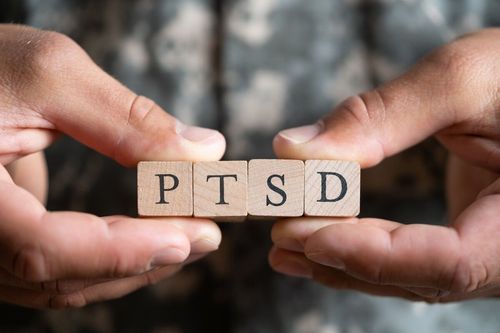Post-traumatic stress disorder (PTSD) is basically an excessive demand in the energy field that does not go away on its own. Unlike short-term shock experiences that trigger a strong reaction and then subside, PTSD remains a persistent condition. This means that sufferers cannot get out of the state of shock. Although they cope with their daily lives, certain triggers – stimuli that resemble the original trauma – can immediately transport them back to the traumatic experience emotionally and affectively.
This constant state of overload causes the emotional experience and physical reactions to traumatic triggers to become uncontrollable. People with PTSD find themselves caught in a cycle that repeatedly draws them back into the traumatic experience, preventing them from leaving it behind.
My name is Rico Brunner, and this post is about post-traumatic stress disorder and how to heal it.
How can PTSD be cured?
PTSD can be cured, but the road to recovery is often long and challenging. The most important starting point is stability, because trauma overwhelms the being, the sensations, the feelings and the mind to such an extent that the entire foundation of life is shaken. This overwhelming pressure “pulverizes” inner stability, and those affected lose the ground under their feet. This leads to a cycle of recurring negative experiences.
To heal PTSD itself, the focus must therefore be on building stability. If enough stability can be created in a person's life, their natural self-healing powers become activated. However, this process is challenging because PTSD itself attacks and hinders the process of building stability. It's a race: if stability grows faster than the PTSD can dismantle it, the PTSD will gradually be overcome.
This is a long-term process that requires time and persistence. But as soon as stability is strong enough to compensate for and ultimately overcome the overwhelming effects of PTSD, the stress disorder begins to disappear. Stability is thus the key to healing from PTSD.
What are the symptoms of PTSD?
Symptoms of PTSD often manifest themselves in the form of emotional, physical and mental reactions to stressful situations. Those affected experience repeated states of stress, which can be activated by similar or completely different triggers. Typical physical symptoms include:
- Shortness of breath
- Anxiety
- Stress
- A feeling of a lump in the throat
On a mental level, PTSD often manifests itself in the form of a feeling of no longer being able to live out one's own natural behavior. This symptom can be so strong that it severely restricts everyday life and makes it impossible for those affected to act as usual or to develop further.
It is important to distinguish between hurdles in life and actual symptoms of PTSD. Hurdles are challenges that you tend to avoid if they seem unpleasant or uncomfortable. These usually do not lead to panic or severe stress reactions, but rather signal an uneasiness that can be overcome.
PTSD symptoms, on the other hand, are characterized by intense stress reactions and panic in certain situations. These are clearly different from hurdles and make it clear that PTSD is a profound problem that should be addressed.
Can you heal PTSD yourself?
Yes, you can heal PTSD yourself by focusing on becoming more stable and stronger. The key is to win the race between stability and PTSD. It doesn't matter whether you are supported by a therapist or work on yourself independently. What is important is that you strengthen your inner stability to reduce the effects of PTSD.
Through self-work, you can build the stability you need to compensate for the stress-inducing mechanisms of PTSD. As your stability increases, PTSD loses its power because the triggered stress has less and less of an effect. The more stable and resilient you become, the more likely it is that you will be able to fully recover from PTSD. Regaining your own strength and resilience is the key factor in the healing process.
What steps promote self-healing from PTSD?
To promote self-healing of PTSD, it is crucial to focus on measures that both strengthen and do good. At the same time, it is important to actively face life instead of avoiding challenges or stressful situations. This approach helps to gradually build stability.
Steps to promote self-healing:
- Start with the areas that are easy to stabilize: It makes sense to start with the areas of life that are easier to stabilize. This way, you will quickly see the first successes, which will give you courage and strength for the next steps.
- Then stabilize the more difficult areas: Once the simpler areas are stabilized, you can turn your attention to the areas that require a little more effort. The stability gained from the initial successes will help you to better overcome these challenges.
- Work your way to the most difficult areas: Over time, the most difficult aspects can also be addressed. The stability previously created makes it easier to master them.
- Avoid evasion: It is crucial not to flee from difficult situations or to only do what seems pleasant while fleeing. Facing challenges strengthens inner stability in the long term.
With this step-by-step approach, the stability gained spreads further and further, creating a foundation that makes it possible to overcome PTSD little by little. Each stabilized area supports the next, making it easier to overcome even the most difficult challenges.
What techniques help with stabilization for healing from PTSD?
Stabilization plays a crucial role in healing PTSD, but the techniques that are helpful depend heavily on the individual situation of the person affected. There is no universal method that works for everyone, because every case of PTSD is unique. Nevertheless, there are approaches that can often be supportive:
Stabilization techniques:
- Physical exercise: Many sufferers report that physical activity is a helpful method of reducing stress. Whether it's going for a walk, light training or dancing – movement helps the body to reduce the stress triggered by PTSD and to find inner peace.
- Take breaks: Regular breaks in your daily routine can help to calm the nervous system and avoid feeling overwhelmed. It is especially important to consciously take time to recover in challenging situations.
- Discover your own healing path: Questions like “What helps me feel more stable?”, “Which activities or situations still hurt me?” or “What drains me, and what gives me strength?” can guide you toward what truly supports your healing process.
- Flexible approach: Since every PTSD case is different, those affected should remain flexible and try out different techniques. The healing process often involves developing personal strategies that are specifically tailored to one's own needs.
Stabilization is a dynamic process in which one continuously learns to understand oneself better. Patience and a willingness to seek individually tailored solutions are key to overcoming PTSD in the long term.
How do you cope with emotional triggers in the case of PTSD?
Emotional triggers in PTSD are an indication of deep wounds, overwhelming stress and traumatization. These triggers cannot be overcome by mere control, suppression or repression. Instead, the key to overcoming emotional triggers lies in maintaining and increasing one's own stability.
Why stability is the deciding factor:
When inner stability is sufficiently high, emotional triggers are not activated in the first place. This means that the focus does not have to be on the triggers or the traumas themselves, but entirely on strengthening personal stability. Stability gives those affected the strength to compensate for stress-inducing mechanisms and achieve lasting healing in the long term.
The most sustainable way:
- Focus on stability: Instead of confronting triggers directly, energy should be spent on strengthening stability. This significantly reduces the risk of being overwhelmed by emotional triggers.
- Stability as a protective shield: Strong stability acts as a protective shield that prevents triggers from reactivating old traumas. This makes dealing with potential triggers in everyday life easier and safer.
This approach is the most sustainable way to cope with triggers because it strengthens the foundation of healing rather than just seeking short-term solutions. Stability is the basis for successfully overcoming emotional challenges in the long term.
How long does it take to heal from PTSD?
Healing from PTSD is a complex and long-term process because it involves a profound violation of the energy field. In most cases, this process takes several years because PTSD often affects different levels of being and requires comprehensive stabilization.
The healing process in detail:
1. Initial improvements:
Many sufferers experience the first positive changes in the first three to twelve months after starting the healing process. They notice:
- “I still have problems, but I feel better in many areas.”
- “I feel more stable, even if triggers are still activated in stressful situations.”
This phase is an important milestone because it shows that the healing process has been set in motion and stability is slowly increasing.
2. A long-term approach:
Healing from PTSD should not be seen as a goal to be achieved within a fixed time frame. Instead, it is helpful to think of healing as a process-oriented development. Bit by bit, stability is built up and life is improved in more and more areas.
3. Patience and persistence:
Healing from PTSD involves continuous work to strengthen stability and reduce the stress caused by trauma. It is rarely a linear process, but rather a progression in small but significant steps.
This process-oriented approach helps to avoid being put under pressure by unrealistic expectations and instead focuses on continuously building stability. Over time, healing becomes a part of life that brings more and more positive change.
What steps lead to a stable life after healing from PTSD?
After recovery from PTSD, it is crucial to consolidate the stability achieved in the long term to avoid relapses. Although PTSD seems to have been overcome, stress and excessive demands can cause old patterns to be reactivated. The key to a stable life after PTSD is to gradually become “wind and weatherproof”.
The three stages of stability after PTSD:
- Stability in fair weather: In the first phase, you feel stable and symptom-free – as long as life runs smoothly. It symbolizes a state of “fair weather”: when no challenges arise, life functions smoothly and without signs of PTSD.
- Stability in rain and cloudy skies: The next level of stability is when you have learned to deal with difficult life situations. Even when you are facing problems or stress, you remain stable and are no longer overwhelmed by PTSD triggers. It is comparable to “cloudy weather or rain”, where you can feel difficulties but can cope with them without relapsing.
- Wind- and weatherproof stability: The last and highest level of stability means that you are able to cope with even extreme stressful situations or crises without a return of PTSD. Symbolically, this corresponds to the state of being “wind and weatherproof”: neither storms, rain, snow nor hurricanes can endanger your inner stability.
Steps to a stable life:
- Step-by-step stabilization:Continuous work on personal resilience to move from the first to the last stage of stability.
- Stress management: Develop techniques and strategies to better manage stress and avoid being overwhelmed.
- Long-term self-care: Regular reflection and self-work help to maintain stability even in challenging times.
Stabilization after PTSD requires patience, practice, and persistence. However, with each step you take, you become more resilient and develop the inner strength to remain stable over the long term, independently of external influences.
Conclusion: Self-healing from PTSD is possible, but it takes time
Healing from PTSD is a long-term process that depends on inner stability. Important factors include patience, self-reflection, and the willingness to actively engage with life.
The message is: strong stability leads to a strong life.
By gradually building emotional resilience, the intensity of PTSD can diminish. It's essential to focus not on the symptoms, but on strengthening your inner resources. This makes healing not only possible, but also sustainable.





